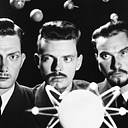Social Networking in Cyber-Ecology
Maybe you’re wondering what the hell this is all about. Well, me too…
Entities
The entity is the atomic unit of what I’m calling (for lack of a better word) cyber-ecology.*
* Cyber-ecology is an attempt to usefully mash together how the natural technologies of living things (ecosystems) work and how human technologies such as computers work, or could work on the emerging hybridized "Internet of Things."So an entity, to me, is kind of like a point in geometry:
From Wikipedia:
“An entity is something that exists as itself, as a subject or as an object, actually or potentially, concretely or abstractly, physically or not. It need not be of material existence. In particular, abstractions and legal fictions are usually regarded as entities. In general, there is also no presumption that an entity is animate, or present.” [Source]
I like that the word “animate” comes up there, because I think there’s a certain utility in borrowing from animism (or maybe even panentheism?) as a lens in understanding entities in emerging cyber-ecosystems.
Animist perspective
Animism basically suggests that everything — whether scientifically considered animate or not — partakes of perhaps a universal spiritual substance, and in some sense is “alive” or has a kind of non-human “person” or “self” of some kind.
Potential POV
I agree that’s animism described that way sounds a bit mysterious (maybe even ‘woo’?), but it seems to jive with my own day-to-day experience of other entities. Regardless, if you’re agnostic about that as a premise, we can strip it down further to be even more flexible:
An entity is a potential point of view (POV), a focal point in a experiential field.
So a rock or a bird, a chair, refrigerator, human, corporation, an A.I., a temperature sensor on a smart-home network — all of those things may serve as a potential point of view when observing, analyzing or situation oneself within a network of relationships. We can look through its eyes (metaphorically, depending), step into its shoes and observe the connections radiating out from that node. There need not be any pre-supposition either about sentience, consciousness, self-awareness or “spirit” of any given node for this to be useful as a way of exploring, talking about and designing entity-networks.*
* And insofar as this, or any, model becomes not useful, it should be discarded. Entangled webs
Just as points in geometry can be linked together with lines and planes to form complex shapes, entities are grouped in associations, assemblages, proximity, networks, fields, biomes and other relationships.
Entities, as nodes in a network, can also be linked together. Links may be, for example, “pathways of exchange” (for transactional tokens) or structures which connect two or more entities together.
When multiple entities are linked together, we can consider this a “network” regardless of who, what, where, or when the entities “are.” That group of linked entities can itself also be considered an entity.
Actants in ANT
Actor-network theory overlaps usefully here, renaming entities as actors/actants in a complex system:
“Actants denote human and non-human actors, and in a network take the shape that they do by virtue of their relations with one another. It assumes that nothing lies outside the network of relations, and as noted above, suggests that there is no difference in the ability of technology, humans, animals, or other non-humans to act… If taken to its logical conclusion, then, nearly any actor can be considered merely a sum of other, smaller actors.”*
* If that doesn’t describe the Internet of Things, I don’t know what does…Witness Linking Sensors
So if an entity is a kind of potential point of view, it would follow that we can attach to it components such as sensors, event listeners, perceptual systems, analysts, translators, etc. to enhance the richness or density of signals associated with that particular point of view. In so doing, we improve the ability of any witness to adopt or analyze that POV and to derive actionable data from it.
In a more “woo” direction, we might say that by witnessing via an entity’s POV, we enable those nodes in a self-experiencing universe to become even more self-experiencing. We make them more animate.
Applied IRL
Here’s one interesting applied example of the above, vis-a-vis forests whose “internet” consists partially of interlinked roots:
“For instance, here [above] is a diagram of the mycorrhizal network for a single 30 by 30 meter plot of British Columbian interior douglas-fir forest. It shows only the douglas-fir trees in the plot (green saw-blade looking things, whose size is proportional to tree diameter), and only two species of mycorrhizal fungus. In reality, there would be a few other species of tree and hundreds more kinds of ectomycorrhizal fungi. Hundreds. This is the wood-wide web.”
The trees are exchanging tokens — water, sugar, chemical and even audio signals — with a mycelial network which transmits in turn to other trees.
See also:
So anyway, yeah, whatever. Blah blah blah. Happy New Year!
#cyber2017

